北师大版高中英语选修七Unit 21 Human Biology Lesson 3 Epidemics Explained课件(34张ppt)
文档属性
| 名称 | 北师大版高中英语选修七Unit 21 Human Biology Lesson 3 Epidemics Explained课件(34张ppt) |  | |
| 格式 | zip | ||
| 文件大小 | 16.5MB | ||
| 资源类型 | 教案 | ||
| 版本资源 | 北师大版 | ||
| 科目 | 英语 | ||
| 更新时间 | 2020-06-22 14:26:50 | ||
图片预览

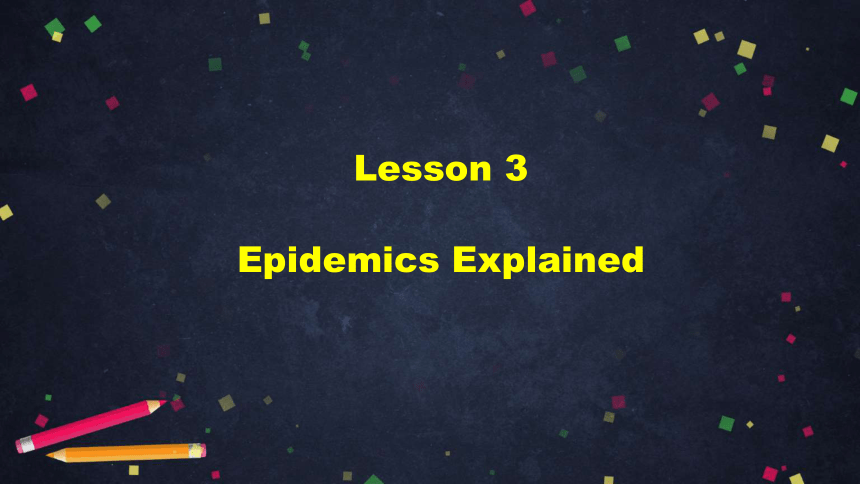
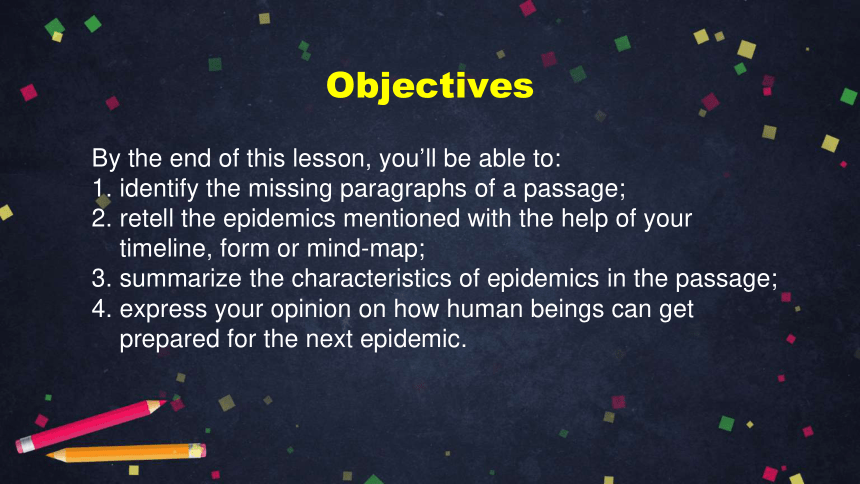



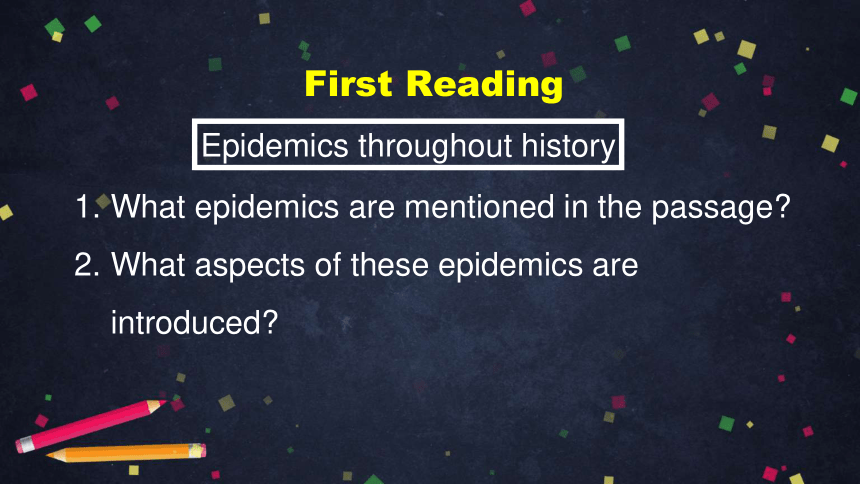
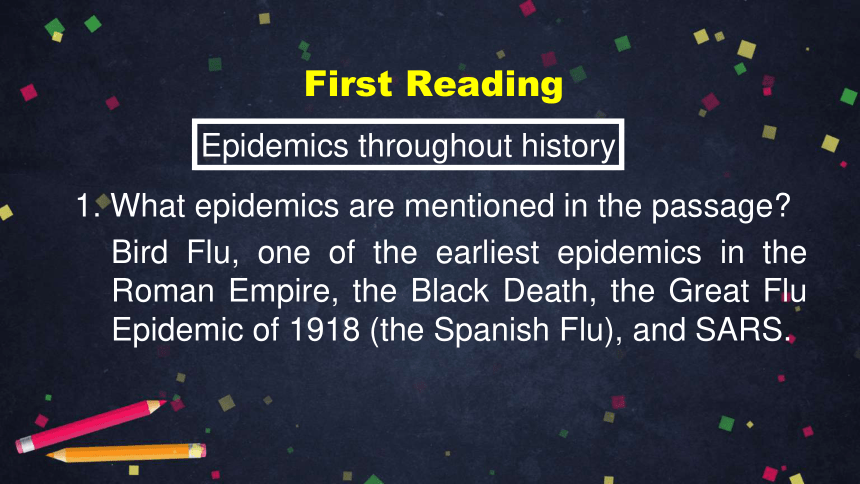
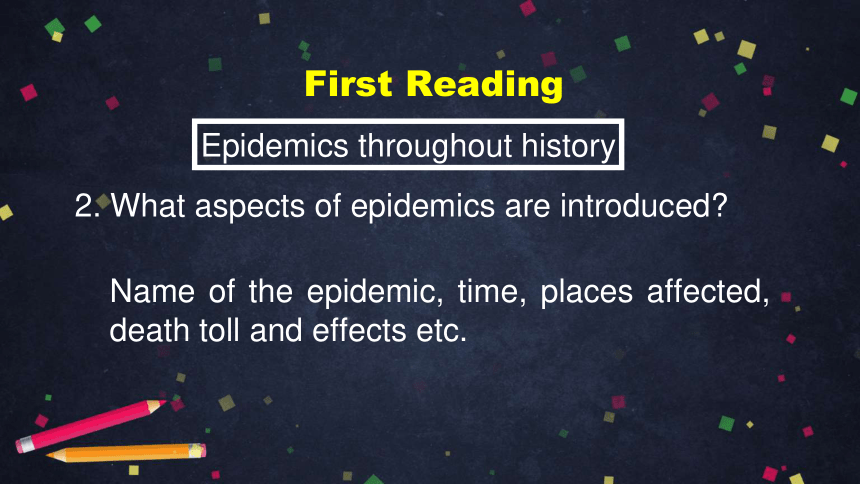

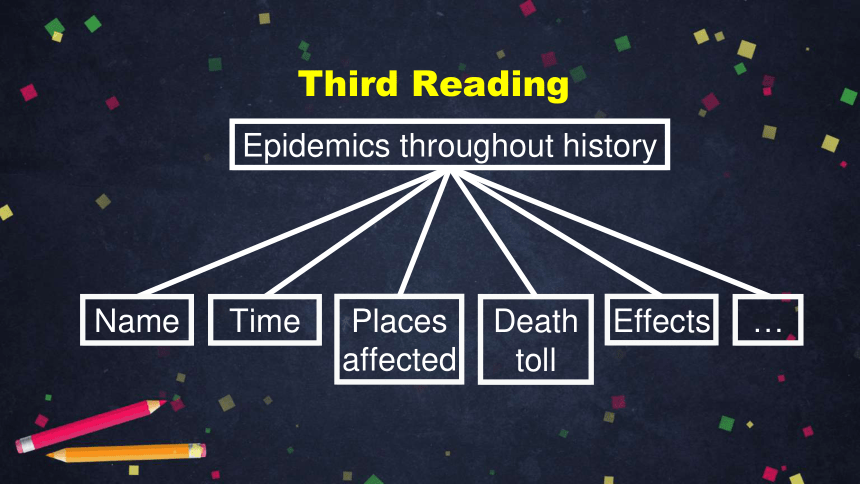

文档简介
(共34张PPT)
选修七
Unit
21
Human
Biology
(5)
高二年级
英语
Lesson
3
Epidemics
Explained
Objectives
By
the
end
of
this
lesson,
you’ll
be
able
to:
1.
identify
the
missing
paragraphs
of
a
passage;
2.
retell
the
epidemics
mentioned
with
the
help
of
your
timeline,
form
or
mind-map;
3.
summarize
the
characteristics
of
epidemics
in
the
passage;
4.
express
your
opinion
on
how
human
beings
can
get
prepared
for
the
next
epidemic.
Epidemic:
a
large
number
of
cases
of
a
particular
disease
happening
at
the
same
time
in
a
particular
community.
Warm-up
Which
of
these
diseases
can
be
epidemics?
AIDS;
cancer;
headache;
heart
disease;
flu;
stomachache
Warm-up
Epidemics
throughout
history
Prediction
Various
epidemics
throughout
history.
What
epidemics
are
mentioned
in
the
passage?
What
aspects
of
these
epidemics
are
introduced?
First
Reading
Epidemics
throughout
history
1.
What
epidemics
are
mentioned
in
the
passage?
First
Reading
Bird
Flu,
one
of
the
earliest
epidemics
in
the
Roman
Empire,
the
Black
Death,
the
Great
Flu
Epidemic
of
1918
(the
Spanish
Flu),
and
SARS.
Epidemics
throughout
history
2.
What
aspects
of
epidemics
are
introduced?
First
Reading
Name
of
the
epidemic,
time,
places
affected,
death
toll
and
effects
etc.
Epidemics
throughout
history
Read
carefully
and
match
the
five
(A-E)
paragraphs
with
gaps
in
the
text
using
the
reading
strategies
on
P38.
Second
Reading
A
E
C
D
B
Para.
3
Para.
5
Para.
8
Para.
10
Para.
12
Third
Reading
Epidemics
throughout
history
Name
Time
Places
affected
Death
toll
Effects
…
Third
Reading
Read
carefully
and
write
down
the
details
of
different
epidemics
by
using
a
timeline,
a
form
or
a
mind-map.
Mind
Map
Epidemics
throughout
history
Time:
500-550AD
Places:
Roman
Empire,
North
Africa,
the
Middle
East
and
Europe
Death
toll:
50%
of
the
population
Effect:
one
of
the
main
causes
of
the
fall
of
Roman
Empire
Epidemics
throughout
history
The
Epidemic
in
Roman
Empire
Time:
in
the
1330’s
Places:
Asia,
Europe,
Africa
and
the
Middle
East
Death
toll:
one
half
of
the
population
Symptom:
black
spots
on
the
body
Epidemics
throughout
history
The
Black
Death
Time:
1918-1919
Places:
all
over
the
world
Death
toll:
50
million
people
in
18
months
Characteristic:
striking
the
young
and
fit
rather
than
the
old
Epidemics
throughout
history
The
Spanish
Flu
Time:
2002-2003
Places:
Guangdong,
Hong
Kong,
Canada,
Vietnam,
Singapore
Death
toll:
774
people
Characteristic:
completely
new,
no
prescription
drugs
Epidemics
throughout
history
SARS
Timeline
Epidemics
throughout
history
500AD
-
550AD
1330s
1918
1997
2002
The
earliest
on
record
The
Black
Death
The
Spanish
Flu
The
Bird
Flu
SARS
Introduction
Timeline
500AD
-
550AD
1330s
1918
1997
2002
The
Black
Death
The
Spanish
Flu
The
Bird
Flu
SARS
swept
through
North
Africa,
the
Middle
East
and
Europe
spread
widely
around
the
world,
up
to
one
half
of
the
population
died
near
the
end
of
the
First
World
War,
a
worldwide
disaster
began
in
China
completely
new
Timeline
The
earliest
on
record
500AD
-
550AD
1330s
1918
1997
2002
The
earliest
on
record
The
Black
Death
The
Spanish
Flu
The
Bird
Flu
SARS
Conclusion
Timeline
Third
Reading
What
do
these
epidemics
have
in
common?
Causes:
bacteria
or
viruses
Outbreak
&
spread:
during
a
war
or
social
disturbance;
overcrowding,
the
rapid
development
of
transportation…
Effects:
great
death
toll;
serious
consequences
for
the
society
Third
Reading
What
do
these
epidemics
have
in
common?
Outbreak
&
spread:
strike
anyone
or
any
country;
spread
through
the
air;
last
for
several
years;
have
adaptations
of
the
previous
viruses.
1.
Why
is
it
important
to
talk
about
the
epidemics
throughout
history?
2.
According
to
the
author,
what
can
people
do
to
prevent
epidemics
in
the
future?
Fourth
Reading
1.
Why
is
it
important
to
talk
about
the
epidemics
throughout
history?
Fourth
Reading
To
discover
the
causes
and
effects
of
epidemics
and
foresee
and
prevent
them
in
the
future.
2.
According
to
the
author,
what
can
people
do
to
prevent
epidemics
in
the
future?
Scientists:
do
trials
on
treatments
Health
experts:
unite,
share
knowledge
and
work
together
Countries:
work
together
to
ensure
thorough
and
systematic
medical
research
Fourth
Reading
Voice
your
opinion
What
do
you
think
we
can
do
to
get
ready
for
future
epidemics?
Watch
a
video
clip
from
Bill
Gates’
speech
and
answer
the
questions:
1.
Does
Bill
Gates
think
we
are
ready
for
the
next
epidemic?
How
do
you
know
that?
2.
What
are
his
suggestions
on
how
to
get
ready
for
the
next
epidemic?
Viewing
Viewing
1.
Does
Bill
Gates
think
we
are
ready
for
the
next
epidemic?
How
do
you
know
that?
Viewing
He
doesn’t
think
we
are
ready
for
the
next
epidemic
because
he
thinks
we
don’t
have
enough
epidemiologists
or
medical
teams
ready
to
go.
2.
What
are
his
suggestions
on
how
to
get
ready
for
the
next
epidemic?
Viewing
Strengthen
health
systems;
Create
a
medical
corps;
Pair
medical
people
with
the
military;
Run
germ
games;
Step
up
research
and
development.
Your
school
will
hold
an
English
Speech
Contest
on
the
topic
of
epidemics.
Make
a
speech
on
what
human
beings
can
do
to
get
prepared
for
the
next
epidemic.
Speaking
At
the
end
of
this
lesson,
can
you:
1.
identify
the
missing
paragraphs
of
a
passage?
2.
retell
the
epidemics
mentioned
with
the
help
of
your
timeline,
form
or
mind-map?
3.
summarize
the
characteristics
of
epidemics
in
the
passage?
4.
express
your
opinion
on
how
human
beings
can
get
prepared
for
the
next
epidemic?
Self-assessment
Retell
the
passage.
Make
a
poster
about
epidemics.
Homework
选修七
Unit
21
Human
Biology
(5)
高二年级
英语
Lesson
3
Epidemics
Explained
Objectives
By
the
end
of
this
lesson,
you’ll
be
able
to:
1.
identify
the
missing
paragraphs
of
a
passage;
2.
retell
the
epidemics
mentioned
with
the
help
of
your
timeline,
form
or
mind-map;
3.
summarize
the
characteristics
of
epidemics
in
the
passage;
4.
express
your
opinion
on
how
human
beings
can
get
prepared
for
the
next
epidemic.
Epidemic:
a
large
number
of
cases
of
a
particular
disease
happening
at
the
same
time
in
a
particular
community.
Warm-up
Which
of
these
diseases
can
be
epidemics?
AIDS;
cancer;
headache;
heart
disease;
flu;
stomachache
Warm-up
Epidemics
throughout
history
Prediction
Various
epidemics
throughout
history.
What
epidemics
are
mentioned
in
the
passage?
What
aspects
of
these
epidemics
are
introduced?
First
Reading
Epidemics
throughout
history
1.
What
epidemics
are
mentioned
in
the
passage?
First
Reading
Bird
Flu,
one
of
the
earliest
epidemics
in
the
Roman
Empire,
the
Black
Death,
the
Great
Flu
Epidemic
of
1918
(the
Spanish
Flu),
and
SARS.
Epidemics
throughout
history
2.
What
aspects
of
epidemics
are
introduced?
First
Reading
Name
of
the
epidemic,
time,
places
affected,
death
toll
and
effects
etc.
Epidemics
throughout
history
Read
carefully
and
match
the
five
(A-E)
paragraphs
with
gaps
in
the
text
using
the
reading
strategies
on
P38.
Second
Reading
A
E
C
D
B
Para.
3
Para.
5
Para.
8
Para.
10
Para.
12
Third
Reading
Epidemics
throughout
history
Name
Time
Places
affected
Death
toll
Effects
…
Third
Reading
Read
carefully
and
write
down
the
details
of
different
epidemics
by
using
a
timeline,
a
form
or
a
mind-map.
Mind
Map
Epidemics
throughout
history
Time:
500-550AD
Places:
Roman
Empire,
North
Africa,
the
Middle
East
and
Europe
Death
toll:
50%
of
the
population
Effect:
one
of
the
main
causes
of
the
fall
of
Roman
Empire
Epidemics
throughout
history
The
Epidemic
in
Roman
Empire
Time:
in
the
1330’s
Places:
Asia,
Europe,
Africa
and
the
Middle
East
Death
toll:
one
half
of
the
population
Symptom:
black
spots
on
the
body
Epidemics
throughout
history
The
Black
Death
Time:
1918-1919
Places:
all
over
the
world
Death
toll:
50
million
people
in
18
months
Characteristic:
striking
the
young
and
fit
rather
than
the
old
Epidemics
throughout
history
The
Spanish
Flu
Time:
2002-2003
Places:
Guangdong,
Hong
Kong,
Canada,
Vietnam,
Singapore
Death
toll:
774
people
Characteristic:
completely
new,
no
prescription
drugs
Epidemics
throughout
history
SARS
Timeline
Epidemics
throughout
history
500AD
-
550AD
1330s
1918
1997
2002
The
earliest
on
record
The
Black
Death
The
Spanish
Flu
The
Bird
Flu
SARS
Introduction
Timeline
500AD
-
550AD
1330s
1918
1997
2002
The
Black
Death
The
Spanish
Flu
The
Bird
Flu
SARS
swept
through
North
Africa,
the
Middle
East
and
Europe
spread
widely
around
the
world,
up
to
one
half
of
the
population
died
near
the
end
of
the
First
World
War,
a
worldwide
disaster
began
in
China
completely
new
Timeline
The
earliest
on
record
500AD
-
550AD
1330s
1918
1997
2002
The
earliest
on
record
The
Black
Death
The
Spanish
Flu
The
Bird
Flu
SARS
Conclusion
Timeline
Third
Reading
What
do
these
epidemics
have
in
common?
Causes:
bacteria
or
viruses
Outbreak
&
spread:
during
a
war
or
social
disturbance;
overcrowding,
the
rapid
development
of
transportation…
Effects:
great
death
toll;
serious
consequences
for
the
society
Third
Reading
What
do
these
epidemics
have
in
common?
Outbreak
&
spread:
strike
anyone
or
any
country;
spread
through
the
air;
last
for
several
years;
have
adaptations
of
the
previous
viruses.
1.
Why
is
it
important
to
talk
about
the
epidemics
throughout
history?
2.
According
to
the
author,
what
can
people
do
to
prevent
epidemics
in
the
future?
Fourth
Reading
1.
Why
is
it
important
to
talk
about
the
epidemics
throughout
history?
Fourth
Reading
To
discover
the
causes
and
effects
of
epidemics
and
foresee
and
prevent
them
in
the
future.
2.
According
to
the
author,
what
can
people
do
to
prevent
epidemics
in
the
future?
Scientists:
do
trials
on
treatments
Health
experts:
unite,
share
knowledge
and
work
together
Countries:
work
together
to
ensure
thorough
and
systematic
medical
research
Fourth
Reading
Voice
your
opinion
What
do
you
think
we
can
do
to
get
ready
for
future
epidemics?
Watch
a
video
clip
from
Bill
Gates’
speech
and
answer
the
questions:
1.
Does
Bill
Gates
think
we
are
ready
for
the
next
epidemic?
How
do
you
know
that?
2.
What
are
his
suggestions
on
how
to
get
ready
for
the
next
epidemic?
Viewing
Viewing
1.
Does
Bill
Gates
think
we
are
ready
for
the
next
epidemic?
How
do
you
know
that?
Viewing
He
doesn’t
think
we
are
ready
for
the
next
epidemic
because
he
thinks
we
don’t
have
enough
epidemiologists
or
medical
teams
ready
to
go.
2.
What
are
his
suggestions
on
how
to
get
ready
for
the
next
epidemic?
Viewing
Strengthen
health
systems;
Create
a
medical
corps;
Pair
medical
people
with
the
military;
Run
germ
games;
Step
up
research
and
development.
Your
school
will
hold
an
English
Speech
Contest
on
the
topic
of
epidemics.
Make
a
speech
on
what
human
beings
can
do
to
get
prepared
for
the
next
epidemic.
Speaking
At
the
end
of
this
lesson,
can
you:
1.
identify
the
missing
paragraphs
of
a
passage?
2.
retell
the
epidemics
mentioned
with
the
help
of
your
timeline,
form
or
mind-map?
3.
summarize
the
characteristics
of
epidemics
in
the
passage?
4.
express
your
opinion
on
how
human
beings
can
get
prepared
for
the
next
epidemic?
Self-assessment
Retell
the
passage.
Make
a
poster
about
epidemics.
Homework
